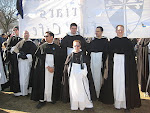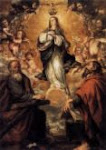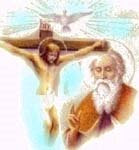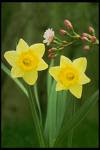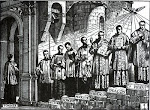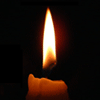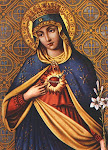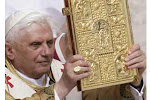These pictures are all taken inside the St David's Metropolitan Cathedral in the centre of Cardiff on September 22nd 2009. The photographs show what happened inside the Cathedral only. Unfortunately thousands more turned up from all over Wales and many ended up not being able to get into the cathedral for the liturgy which was a source of sadness, although all who wanted to came to venerate the reliquary which housed the little saint's bones.
Below you can see all the people who came from Wales, religious from everywhere, including the Carmelite sisters from Dolgellau,Cistercians from Caldey Island, Franciscans, Sisters of Joseph of Annecy from Cwmbran, Newport and Cardiff, Carmelites from West Wales and Mother Theresa's 'Sisters of Charity' from Cardiff who are working with the poor. All three bishops, including our own Archbishop Peter were in evidence, and there were many interesting and inspiring insights into the life of the Saint.
Below there are also some pictures of the Cathedral itself, a small oak carving of St David of Wales, who defended the Church's teaching against Pelagius (Morgan) at Llandewi Brevi and was canonised for it in 1138 by Pope Callixtus II.I wonder what he thought of the magnificent crowds!
During the day the age range was older, supplemented by many mothers with babes-in-arms and younger people unwaged. There were also a large number of children. By the end of the evening mass, many many younger people had joined the fray and I mean literally, since several thousand more people turned up than there was room for in such a small cathedral. In fact many workers leaving offices had got in for the evening Mass and turned up bearing bouquets or bunches of red roses to leave with St Theresa. The Third Order Carmelites were looking after the long queue.
Below, you can also see the representation of the statue held at Penrhys, a most beautiful one, traditionally carved out of oak. It had been dragged off to London and burned in Thomas Cromwell's back yard!This too is very beautiful, although I think the original may have been more brightly coloured....
There is also a marble pieta, after the one in the Lateran basilica. See below my report of my day....

_________________________________________________________
Our Lady of Penrhys in St Joseph's Chapel























__________________________________________________________________________________________________________________________________________________________________________
ArrivalSince I am not currently living in Wales, although just over the border, I left very early intending to drive to Cwmbran and get a train. This was not possible as there were no parking places at Cwmbran station, so I drove over the mountain road and into Cardiff itself. My many years at Welsh National Opera meant I have a working knowledge of the road system and I got into my usual car park in Greyfriars.
I realised it would cost me £12 to park there all day, but considering a train fare and taxi fares etc-not too bad really, and only a short walk up to the Cathedral. When I arrived I went into the gift shop first, realising it would be swamped later and got a few small candles and also some small prayer books, as my sister, an Anglican is very interested in St Therese and there are several excellent small prayer books and cards.Then, entering the church, I lit some candles for my family. I especially prayed for my grandfather, William Earnest, because he had malaria in the first world war and there had been an enormous change in his personality which was a big trial for my grandmother. He was a Catholic but in a fit of rage refused extreme unction at the end of his life, often being prey to these fits.I prayed for my other dead grandparents, my father and my husband and son. I also resolved to give my plenary indulgence to my grandfather, who himself had suffered a lot in the war, and hope that he is now with the Father. Gradually, the cathedral filled up with people and there was not a seat to be had for the first Mass.
The Theme of the Pilgrimage was threefold and the first was Vocations in the Year of the Priest.So the first Mass was for vocations and two big boards proclaiming this were placed rather close to the altar obscuring the view of the Sanctuary, which I found really irritating suring the Exposition of the Blessed Sacrament, as it was important to see it from any angle. The Mass began with the hymn 'Come Holy Spirit'-Veni sancte Spiritus' sung by all in plainchant. Several priests spoke about this. The sermon emphasised that like St Therese who was 'surrounded by love', and that love was at the heart of the Church, that the priest was also love at the heart of the church. Another Priest from Usk then, as Director for vocations, young and strongly spoken , also spoke inspiringly and powerfully about love being the heart of the church and even more powerful than faith and hope, and lastly another priest from West Wales spoke softly about all the duties a priest has to fulfil, how essential the priest is in the life of the church, and that young people will only be able to combat outside cultural relativist forces if we witness our faith in love, but also in explanation of
whythe church has certain teachings. Also we should challenge suitable young men, showing the quality of love and care , to ask them to consider being a priest.


______________________________________________________________________________________
Arrival of the RelicsAround 3.15 in the Cathedral (there had been an hour's Exposition of the Blessed Sacrament' as the MC had to remind people constantly as there was so much excitement at the expectation of the relics and many people had come together with people from former parishes or different parts of Wales and had begun to talk in Church. Thankfully the offending boards were taken away, but I could only see the Blessed Sacrament by twizzling my head around those boards! The cathedral filled up with people pouring in and filling all the side chapels. Men women, little children and the excitement was huge, but thousands remained outside and were unable to get in. The seating capacity was far too small, and I did wonder whether the Anglican authorities might have loaned us Llandaff for the visit. (So upsetting to pay for your coach, arrive and be kept out in the light rain. )
Finally inside the cathedral, we heard the sound of clapping and cheering and a procession began to form. The Knights of St Gregory appeared at the door and were carrying the flags of Normandy and Wales, the papal flag and another flag I did not recognise. For the first time the huge and powerful organ droned forth in a magnificent fanfare. He was a fantastic organist! The flags started to moe down the central aisle of the church and stood behind the eight votive stands, all filled with candles with incense wafting down the church. Behind were members of all the religious orders in Wales and Third Order Carmelites, the bearers of the reliquary, all wearing black suits who placed it on the plinth at the front. Seats had been saved for them. Then as the Bishops followed it, led by Archbishop Peter, the rite of receiving the relic of the magnificent saint into Cardiff was begun with the hymn 'For all the saints who from their labour's rest'. During the coffin's being brought down the aisle there was a prolonged period of clapping to welcome 'the Little Flower'and congratulate her for her inspiring life, lived all at her home and in her Carmel and dying at such a young age, utterly devoted to the way of holiness in the 'little things'. A link could have been made here to our own holy saint David, who preached to all-'Always the little things, remember the little things',making people special who have been sidelined by respecting their creation in God, a special cup of tea for that difficult person, excercising patience with difficult people.....etc.
There followed an address by Bishop Edwin about St Therese by firstly Bishop Edwin of North Wales, a lovely warm , approachable bishop with a great sense of humour who began by saying, 'I have been asked to preach in Welsh for the first part, but for those who do not speak the language of heaven....'the pause allowed laughter from the congregation, 'I will say it again in English'. It was charming. He mentioned the letter of St Paul, where Paul had talked about the Church being the limbs and 'body' of Christ. Therese had said, she wanted tobe its heart, and in her short life in her Carmel (Convent of Carmelites) she prayed unceasingly for priests, vocations and for Love in the church, she had assimilated from her own happy home, and probably the reason why Pope Benedict may also beatify her parents. She is the patron saint of missions and evangelisation and her 'Little Way Association' raises money for third world countries, for life giving essentials and formation of priests.
The Bishop of Menevia spoke on similar themes as did Archbishop Peter, reminding everyone that we are all priestsand we all have the duty of evangelisation put upon us.We all have to proclaim the gospel, however unpopular we may be.He spoke warmly and fervently for the need for Christ in a broken world. The Choir of St David's , before the Mass had entered. A mixture of boys and girls sang-and had led the Benediction with 'O Salutaris Hostia' and 'Tantum Ergo' in the plainchant. I was so relieved that the music was in a traditional setting.
Following on from the welcome , all three bishops came down and in a line venerated the reliquary of St Therese (encased in a perspex box)Then followed all the priests, the Cistercians of Caldey Island, the Carmelites from Dolgellau (who had a lot of young nuns) and since everyone was focused on the veneration, I made my way to the Confessional as I had missed the boat earlier as hundreds lined up for confession. This was a profoundly healing experience, but as I attempted to get into the line for veneration a very angry woman who had not been able to get in started accusing me of coming down from the gallery and pushing in! She wouldn't listen to the truth, but I just waited, then a priest who had seen what was going on intervened and invited me to come in. I think she had been causing trouble elsewhere, but had I not gone to confession, I would have been at the front of the queue, and it did not really matter anyway and I had just waited.Still I was glad to finally get there.
The ReliquaryAt the side of the Reliquary were all the votive stands shimmering with candles, the huge painting of the Saint sent by the Carmel at Lisieux to accompany it. It was so beautiful to see this and , I felt a reflection of the beauty and sanctity of the life of St Therese, because along with the themes of Evangelisation, and Vocation there was also the third theme, the sanctification of the Christian life, by souls as St Therese said , 'throwing themselves into the arms of Jesus' when confronted by the tempation of serious unChristian behaviour. The reception readings 'Unless you become like a little Child, you cannot enter the Kingdom' relected the life of the little saint completely. Perhaps actually a child, but warm, loving giving and totally dedicated to God's Will and in her book 'Story of a Soul' in which she simply sets out her faith in 'Little Things'(exacly echoing St David's creed) is a bestseller and she is one of only three women named as a 'Doctor' of our church-one who sets out the faith clearly.
My Confessor had asked me to pray for him at the Reliquary and for all priests.He had been gentle and reassuring and asked me to pray the 'Angelus' for my penance.So I had a lot to do. The reliquary in its glass case was very beautiful and ornate box of traditional design, gilded and painted with many colours.It lay in a sea of red roses and other flowers the pilgrims had brought to honour this little saint, and looking up and seeing the statue of St David looking down, was very moving. Third order Carmelites were on each side of the glass case and I walked forward aware of candles and flowers all around, along with the smell of the incense. I decided not to kiss the box, but to lay my hand upon it, pray for the priest and say 'Thank you' before moving off to pray-I realised so many people were waiting.I then prayed for all the Pope's intentions and offered my plenary indulgence for my grandfather and curiously as I did this, it was like someone else spoke to me and said 'Thank you Evi'. So as it was a plenary indulgence hopefully my grandfather will have his glory. I have heard malaria can do terrible things to the mind.
Finally the crowds were joined by bank and office workers, young people working in the city, arriving with umbrellas and briefcases and more red roses. I think the Archbishop and other bishops were overwhelmed, also by Anglicans who had come and simply people from the street who had come in to see what was there and were overawed by the sight of hundreds of candles, the picture and the sea of red roses with the little casket in the centre. There followed a Meditation and the Litany of the Saints, whilst the veneration went on. The huge crowds now swollen with the city workers had meant the timetable was not infallible either. Finally the choir filed back in and a wonderful Mass for Evangelisation happened. I was only sorry the 'Gloria in excelsis' was not joyous enough but sung to a strange chant. Luckily the music was given.
The psalm was beautifully sung and also the 'alleluia'by a small child in the choir. The highlights were from the choir
'Os Justi' by Bruckner(
The mouth of the righteous offers wisdom and his tongue speaks what is just. The Law of his God is in his heart ;and his feet do not falter) and the setting of the 'Agnus Dei'(Lamb of God, you take away the sins of the world, have mercy on us) from Schubert's
Mass in G as well as the lovely setting by Durufle of the Maundy Thursday motet
'Ubi caritas' (Where there is charity and love,there is God, the love of Christ has gathered us into one flock. Let us rejoice and be joyful in Him.Let us love and fear the living God, and froma sincere heart let us love one another)The singing of the choir was so lovely-I nearly bubbled!The senses were so overpowered by the smells of candles, roses and other flowers and incense and now the singing of angels! The Choirmaster was in control all the time and had obviously worked very hard to get music of this standard. The hymns were
Firmly I believe and truly (from
The Dream of Gerontius by Cardinal Newman(1801-90)
Readings:
Isaiah 2 verses 1-5 (given in Welsh)
Psalm 97:
from a chant by Bairstow The Lord has shown his Salvation to the NationsGospel: John Chapter 17:11-23 and then the soul searching and warm homily given by Archbishop Peter
Communion Hymn was :Lord of all hopefulness, Lord of all Joy, whose trust, ever child-like, no cares could destroy....'
The Ordinary of the Mass was
Cunctipotens genitor Deusand more difficult than the 'Sarum' music in the earlier mass, but since not everyone was singing, it was sung well with a beautiful tenor voice and good to have a rest from singing and just hear beauty!
Recessional:
My God accept my heart this day, and make it always Thine
That I from Thee no more may stray, No more from Thee decline'This was sung to a traditional Welsh tune.
Following the withdrawal of the bishops and clergy, 5 priests set up stations for confession in the chancel and also in the three standard confessionals and huge queues appeared to venerate the little saint and also for confessions. The evening crowd were young fathers and mothers, office workers and bank clerks and people dressed in their Asda, Tesco and other clothes, all come to venerate the little flower, St Therese of the Child Jesus.
on 27th September there is Solomn Mass in the Cathedral and the Mass in G by Franz Schubert will be sung and the motet 'Ave Maria' by Bruckner sung-which is glorious. Both wonderful composers of the Church.Found out the other day that Mozart also had a papal honour and called 'Kavaliere'.
A huge number of the Welsh were there from Angelesey(Mon) to Monmouthshire(Mynwy) and Herefordshire (south of which was historically in Wales)and I even spotted Fr Salvatore from Holywell in Flint there, and many people in the Cathedral were speaking in Welsh. There was colour, excitement and real happiness there and a great coming together of the Faithful so a tremendous occasion. Just sad that a bigger venue could not have been found for this unforgettable day, the nearness to God, the inclusion of all our families, seeing the aged and sick lifted to venerate the little saint and generally the good humouredness of most people, in spite of the disappointment of not getting in for the reception of the relics.For me the most beautiful was my absolution and gaining the plenary indulgence for my grandad.
As I left the church, another queue was forming and the prayers going on non stop for the conversion of Wales and more good evangelising priests, infused with love going out into an broken world where there is so much suffering and turning away from love. 'If ye love me, keep my Commandments'.




























